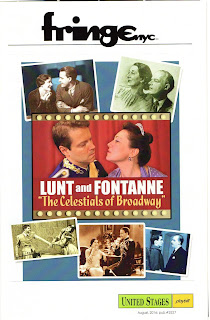"When Broadway's Lights Grow Dim"
 |
| Stars range from 5-1. |
They were among the brightest lights on Broadway but Alfred Lunt (1892) and Lynn Fontanne (1887-1983)—the Lunts—starred in only one Hollywood film (The Guardsman, 1931, adapted from a hit comedy the Lunts had done in 1924) and cameoed (as themselves) in another (Stage Door Canteen, 1943). During their heyday, the New York stage was providing the film industry with one thespian luminary after another—Gable, Bogart, Tracy, Hepburn, Davis, Robinson, Cagney, etc., etc.—but the Lunts were reluctant to leave the footlights for the kliegs.
 |
| Alison Murphy, Mark E. Lang. Photo: Siggi Ragmar. |
 |
| Alison Murphy, Mark E. Lang. Photo: M.P. Myers. |
Theatre geeks will know of the Lunts, of course, and anyone who’s seen a play at Broadway’s Lunt-Fontanne Theatre, named after them in 1958 when they opened there in Dürrenmatt’s The Visit, is at least familiar with their names if not their reputations; for many others, they might as well be Samuel J. Friedman. The general public, I suspect, has as little knowledge of them as those students someone recently interviewed who had no idea of who fought the Civil War. I never saw the Lunts in person, but, growing up in the 1940s and 1950s, I was very familiar with them; I remember my excitement when they performed twice in TV specials, first in The Great Sebastians (1957), and next when they played Mr. and Mrs. Oliver Wendell Holmes in The Magnificent Yankee (1965).
In Lunt and Fontanne, an offering of this year’s New York International Fringe Festival, Mark E. Lang has attempted to compress the lives and art of these fabled players into an hour and a half one-act in which Lang plays Lunt and his real-life spouse, Alison Murphy, covers Fontanne; they also play several other characters, mostly celebrities. The time covered is roughly from when they fell in love and married in 1922 to the opening night of The Visit in 1958.
Unlike the recent Lunts-based play Ten Chimneys, about a specific moment in their lives, it’s a more or less by-the-numbers biodrama that combines dramatized scenes from the stars’ private life, with expository monologues and, most interesting, scenes from several of the plays (frequently produced by the Theatre Guild) that made the Lunts the Lunts. The best of these is constructed as a rehearsal of The Taming of the Shrew during which their real-life personalities intrude on their role-playing, a situation the play later acknowledges influenced Cole Porter when he wrote Kiss Me, Kate.
An attempt is made to wring some drama out of the Lunts’ personal lives, but, despite a through-line concerning Alfred’s lack of self-confidence, the childless couple (her preference) lived a relatively untroubled life. As any Luntian knows, their summers were spent enjoying the pleasures of Lunt’s sprawling family home and farm in Genesee Depot, Wisconsin, now a visitors’ shrine to their careers. They bickered about whether to sign a big Hollywood contract—he was tempted by the money, she found movie acting boring and artistically stultifying. They bravely ventured onto the London stage during World War II in order to bring their lauded performances of Sherwood’s uplifting war drama There Shall Be No Night (1940) to the besieged city’s theatregoers. And they fretted about being passé when the postwar years brought a new kind of realistic acting (think the Method) to the stage; Lunt was disappointed when turned down for the role of Willy Loman in Death of a Salesman.
Names and play titles are dropped prolifically in Lunt and Fontanne and, with selective costume elements (thanks to designers Viviane Galloway and Jessa-Raye Court) taken from nearby hat stands, we get to see theatre notables Nöel Coward, Lawrence Olivier, Vivien Leigh, and even a mumbling Marlon Brando. Neither Lang nor Murphy, however, is a gifted impressionist so we accept their impersonations at face value, pasting our own memories of these stars (those of us who still remember) over their flaccid representations. The actors, who bear no resemblance to the Lunts, are professionally smooth, but lack the charisma, polish, and charm of the originals; those who have no idea of what the Lunts were like—dated staginess and all—should check out the film of The Guardsman, a clip of which can be found here.
Lunt and Fontanne: The Celestials of Broadway offers a conventional overview of the careers of two great stars the lights of whose memories have dimmed, partly because they refused the lure and lucre of Hollywood. It may prove catnip for those interested in the work and lives of these legendary actors, but, without performances even closely approximating the originals, it remains a pleasant, educational, but ultimately superficial exercise in theatrical nostalgia.
OTHER VIEWPOINTS:
64E4 Mainstage
64 E. 4th St., NYC
Through August 27

